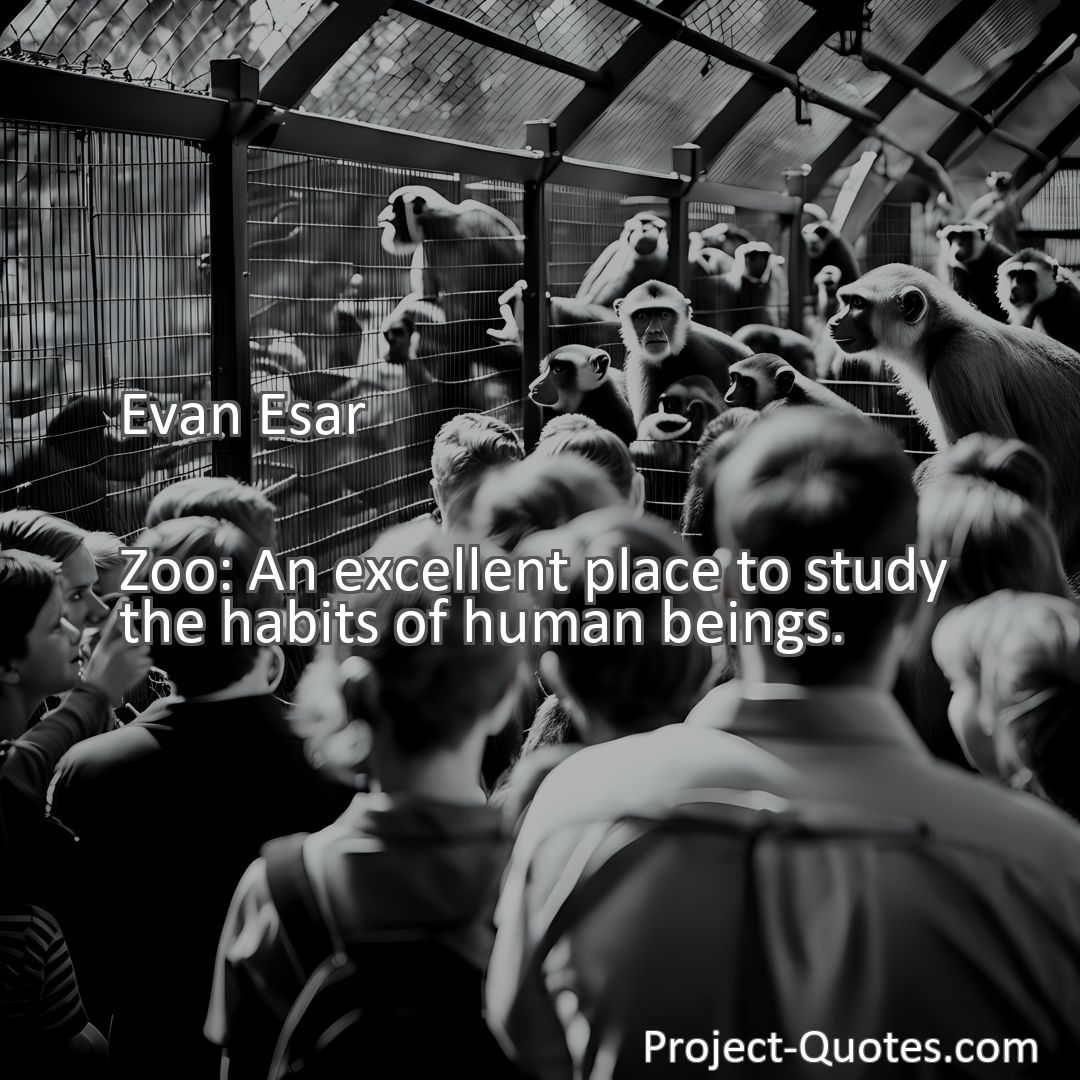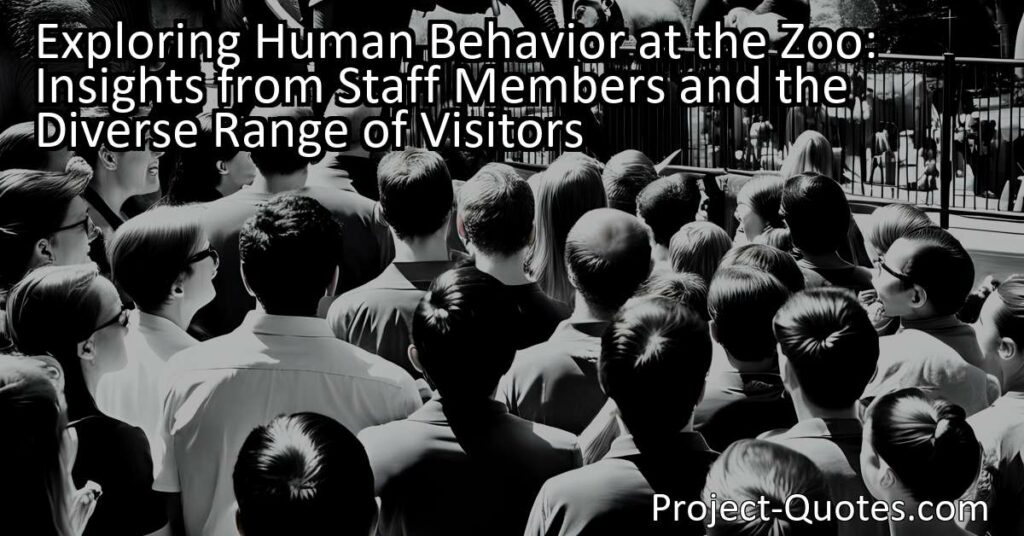Zoo: An excellent place to study the habits of human beings.
Evan Esar
Exploring Human Behavior at the Zoo: Insights from Staff Members and the Diverse Range of VisitorsGet ready to be amazed at the diverse behaviors of human beings on display at your local zoo! From families teaching their kids about animals to teenagers capturing every moment on social media, the zoo offers a unique opportunity to study human habits. Don’t forget to observe the passionate zookeepers and the fascinating behaviors of the animals themselves, as they provide valuable insights into our own societal patterns.
Table of Contents
Meaning of Quote – Zoo: An excellent place to study the habits of human beings.
Have you ever wondered where you can go to observe the fascinating behaviors of human beings? Well, look no further than your local zoo! As the renowned American humorist Evan Esar once said, “Zoo: An excellent place to study the habits of human beings.” This seemingly simple quote carries a profound truth beneath its lighthearted tone. Beyond its primary purpose of showcasing the diverse and mesmerizing animal kingdom, the zoo offers a unique opportunity to catch glimpses into our own species’ habits, tendencies, and idiosyncrasies.
One of the most intriguing aspects of zoos is the diverse range of visitors they attract. From families with young children to elderly couples, from solo adventurers to class field trips, people from all walks of life flock to the zoo in search of entertainment, education, and a chance to reconnect with nature. This diverse mix of individuals provides an ideal setting to observe the habits and behaviors exhibited by human beings.
Just like animals in their natural habitats, humans at the zoo display a myriad of behaviors that reflect both individuality and societal influences. Take, for instance, the dynamics of families visiting the zoo. It is not uncommon to spot parents explaining different animal species to their curious children, pointing out their distinctive characteristics and narrating fascinating facts. This interaction between parents and children highlights the innate desire for knowledge and the importance of education that is deeply ingrained in our species.
Furthermore, observing the interactions between families and zoo animals reveals the undeniable shared connection between humans and the animal kingdom. Parents often encourage their children to empathize with the animals, teaching them concepts such as conservation, respect for nature, and the significance of protecting endangered species. These teachings not only reinforce the importance of empathy and compassion but also foster a sense of responsibility towards the environment.
Moving away from families, the behavior of groups of friends or classmates visiting the zoo provides additional insight into the habits of human beings. It is not uncommon to see clusters of excited teenagers, armed with cameras and selfie sticks, capturing every moment of their zoo experience. This behavior reflects the pervasive influence of technology in our lives, as well as the desire to document and share experiences with our social circles. The presence of social media platforms has pushed us to not only experience events firsthand but also to curate and present them to others, highlighting the impact of collective experiences on our sense of identity and belonging.
Moreover, observing the crowd dynamics at the various animal exhibits can shed light on our inherent need for social interaction and the desire to establish a sense of belonging within a community. As people gather around enclosures to catch a glimpse of their favorite animals, there is often a palpable excitement in the air. Strangers strike up conversations, discussing their shared interests and exchanging opinions on the various species they encounter. This collective enthusiasm reflects our communal nature as social beings and highlights the joy that can be found in bonding over shared interests.
Beyond the behavior of zoo visitors themselves, the role of zookeepers and staff members also offers valuable insights into human habits. These dedicated individuals possess in-depth knowledge about the animals in their care, and their interactions with both animals and visitors showcase their expertise and passion for conservation. Observing their interactions with the animals, as well as their ability to communicate complex information to visitors of all ages, serves as a reminder of our capacity for learning, teaching, and passing on knowledge to future generations.
In addition to the human element, the animals themselves contribute to the richness of the human study environment that zoos provide. Animals possess their own distinct habits, behaviors, and social structures, which can serve as a mirror to our own. From the orderly hierarchy of a lion pride to the intricate communication systems of primates, these animal behaviors offer a unique perspective on the diversity and complexity of social dynamics. By understanding these animal behaviors, we can gain a deeper understanding and appreciation of our own societal patterns.
In conclusion, Evan Esar’s quote, “Zoo: An excellent place to study the habits of human beings,” holds true as zoos provide a platform to observe and understand various aspects of human behavior. The diverse range of visitors, the interactions between families and animals, the behavior of groups of friends, and the knowledge and expertise of the zoo staff all contribute to the vibrant tapestry of human habits on display. By spending time at the zoo, we not only have an opportunity to discover more about the animal kingdom but also to reflect on our own species and cultivate a renewed sense of wonder, empathy, and responsibility towards the natural world. So, the next time you visit a zoo, take a moment to observe and marvel at the fascinating habits of human beings that unfold before your eyes.
I hope this quote inspired image brings you hope and peace. Share it with someone who needs it today!


